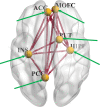A serotonergic biobehavioral signature differentiates cocaine use disorder participants administered mirtazapine
- PMID: 35523779
- PMCID: PMC9076859
- DOI: 10.1038/s41398-022-01934-w
A serotonergic biobehavioral signature differentiates cocaine use disorder participants administered mirtazapine
Abstract
Cocaine use disorder (CUD) patients display heterogenous symptoms and unforeseeable responses to available treatment approaches, highlighting the need to identify objective, accessible biobehavioral signatures to predict clinical trial success in this population. In the present experiments, we employed a task-based behavioral and pharmacogenetic-fMRI approach to address this gap. Craving, an intense desire to take cocaine, can be evoked by exposure to cocaine-associated stimuli which can trigger relapse during attempted recovery. Attentional bias towards cocaine-associated words is linked to enhanced effective connectivity (EC) from the anterior cingulate cortex (ACC) to hippocampus in CUD participants, an observation which was replicated in a new cohort of participants in the present studies. Serotonin regulates attentional bias to cocaine and the serotonergic antagonist mirtazapine decreased activated EC associated with attentional bias, with greater effectiveness in those CUD participants carrying the wild-type 5-HT2CR gene relative to a 5-HT2CR single nucleotide polymorphism (rs6318). These data suggest that the wild-type 5-HT2CR is necessary for the efficacy of mirtazapine to decrease activated EC in CUD participants and that mirtazapine may serve as an abstinence enhancer to mitigate brain substrates of craving in response to cocaine-associated stimuli in participants with this pharmacogenetic descriptor. These results are distinctive in outlining a richer "fingerprint" of the complex neurocircuitry, behavior and pharmacogenetics profile of CUD participants which may provide insight into success of future medications development projects.
© 2022. The Author(s).
Conflict of interest statement
FGM has past research funding from Indivior Pharmaceuticals and Nektar Therapeutics for research unrelated to this study. KAC and NCA have current research funding from VidaLibreBio, Inc., for research unrelated to this study. Other authors declare no competing interests.
Figures




Similar articles
-
Variation within the serotonin (5-HT) 5-HT₂C receptor system aligns with vulnerability to cocaine cue reactivity.Transl Psychiatry. 2014 Mar 11;4(3):e369. doi: 10.1038/tp.2013.131. Transl Psychiatry. 2014. PMID: 24618688 Free PMC article.
-
Altered anterior cingulate cortex to hippocampus effective connectivity in response to drug cues in men with cocaine use disorder.Psychiatry Res Neuroimaging. 2018 Jan 30;271:59-66. doi: 10.1016/j.pscychresns.2017.10.012. Epub 2017 Oct 27. Psychiatry Res Neuroimaging. 2018. PMID: 29108734 Free PMC article.
-
Cingulo-hippocampal effective connectivity positively correlates with drug-cue attentional bias in opioid use disorder.Psychiatry Res Neuroimaging. 2019 Dec 30;294:110977. doi: 10.1016/j.pscychresns.2019.08.005. Epub 2019 Aug 13. Psychiatry Res Neuroimaging. 2019. PMID: 31439409 Free PMC article.
-
Hypothalamic-pituitary-adrenal axis activity in post-traumatic stress disorder and cocaine use disorder.Stress. 2020 Nov;23(6):638-650. doi: 10.1080/10253890.2020.1803824. Epub 2020 Aug 24. Stress. 2020. PMID: 32835581 Review.
-
Molecular genetics of cocaine use disorders in humans.Mol Psychiatry. 2022 Jan;27(1):624-639. doi: 10.1038/s41380-021-01256-1. Epub 2021 Aug 27. Mol Psychiatry. 2022. PMID: 34453125 Free PMC article. Review.
Cited by
-
Cocaine Cues Used in Experimental Research: A Systematic Review.Brain Sci. 2025 Jun 10;15(6):626. doi: 10.3390/brainsci15060626. Brain Sci. 2025. PMID: 40563797 Free PMC article. Review.
-
Deficits in consummatory reward relate to severity of cocaine use.Drug Alcohol Depend. 2023 Aug 1;249:109950. doi: 10.1016/j.drugalcdep.2023.109950. Epub 2023 Jun 1. Drug Alcohol Depend. 2023. PMID: 37301068 Free PMC article.
-
Lorcaserin modulation of semantic drug cue-elicited effective brain connectivity in persons with cocaine and opioid use disorders.Psychiatry Res Neuroimaging. 2025 Jul 23;352:112034. doi: 10.1016/j.pscychresns.2025.112034. Online ahead of print. Psychiatry Res Neuroimaging. 2025. PMID: 40749271
-
Exploring the Role of Reward Functioning in the Overlap of Post-Traumatic Stress and Cocaine Use Disorder.Subst Use Misuse. 2025;60(6):926-932. doi: 10.1080/10826084.2025.2465983. Epub 2025 Feb 18. Subst Use Misuse. 2025. PMID: 39967049 Clinical Trial.
References
-
- NSDUH. Substance Abuse and Mental Health Services Administration, Center for Behavioral Health Statistics and Quality. (September 4, 2014). The NSDUH Report: Substance Use and Mental Health Estimates from the 2013 National Survey on Drug Use and Health: Overview of Findings. Rockville, MD: NSDUH, 2014. - PubMed
-
- Schmitz JM, Green CE, Stotts AL, Lindsay JA, Rathnayaka NS, Grabowski J, et al. A two-phased screening paradigm for evaluating candidate medications for cocaine cessation or relapse prevention: modafinil, levodopa-carbidopa, naltrexone. Drug Alcohol Depend. 2014;136:100–7. doi: 10.1016/j.drugalcdep.2013.12.015. - DOI - PMC - PubMed
-
- McCann DJ, Ramey T, Skolnick P. Outcome measures in medication trials for substance use disorders. Curr Treat Options Psychiatry. 2015;2:113–21. doi: 10.1007/s40501-015-0038-5. - DOI
Publication types
MeSH terms
Substances
Grants and funding
LinkOut - more resources
Full Text Sources
Medical
Miscellaneous

